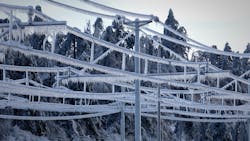FERC Finalizes Plans to Boost Grid Reliability in Extreme Weather Conditions
FERC last week finalized two rules to help improve reliability of the bulk power system against threats of extreme weather that may cause unacceptable risk to life and economic harm.
The first rule directs the North American Electric Reliability Corporation (NERC) to develop a new or modified reliability standard to require transmission system planning for extreme heat and cold weather conditions over wide geographical areas, including studying the impact of concurrent failures of bulk power system generation and transmission equipment and implementing corrective actions as needed (E-1: RM22-10). The second rule directs transmission providers to submit one-time reports describing their policies and processes for conducting extreme weather vulnerability assessments and identifying mitigation strategies (E-2: RM22-16, AD21-13).
“Make no mistake: Reliability at FERC is Job No. 1,” FERC Chairman Willie Phillips said. “For the first time, reliability standards will require planning for extreme heat and cold weather. NERC will develop the standards, and once we approve them transmission owners and operators will identify the elements of their systems that are vulnerable to extreme heat and cold and develop solutions to address those vulnerabilities.”
The new rules stem from the Commission’s June 2021 technical conference on Climate Change, Extreme Weather and Electric System Reliability. A presentation at the Commission meeting, which outlined preliminary assessments from the FERC and NERC teams studying the December 2022 Winter Storm Elliott, underscored the need for the new rules. Since 2011, the country has experienced at least seven major extreme weather events, each of which stressed electric grid operations.
Both rules take effect 90 days after publication in the Federal Register. Each transmission provider must file the one-time informational report required by E-2, the second final rule, 120 days after publication in the Federal Register
